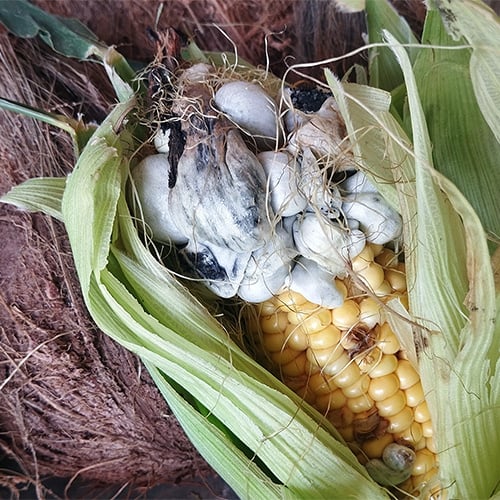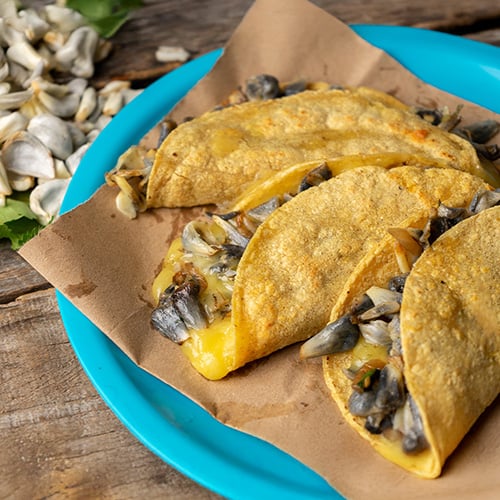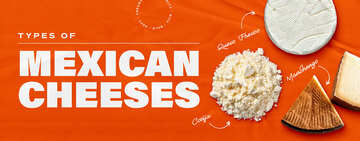What Is Huitlacoche?
Last updated on Apr 17, 2025Jason KurtzHuitlacoche, sometimes spelled cuitlacoche, is a fungus that grows on organic corn before its ears are fully developed. In Hispanic cuisine, many view huitlacoche as a delicacy, using it as a topping or ingredient in a wide range of Hispanic dishes to bring depth of flavor and a touch of elegance to their menu. Also known as corn smut, huitlacoche resembles large, bulbous, grayish masses that form in the place of corn kernels. The fungus is relatively rare and typically only forms in the right conditions, requiring wet, rainy weather as corn ripens to form. Because of this, huitlacoche has a small window of seasonality, peaking between July and September.
How to Pronounce Huitlacoche
The correct pronunciation of huitlacoche is weet-luh-KOH-chay. The word huitlacoche is derived from Nahuatl, the language of the Aztecs, and has been adopted into traditional Spanish over time.
What Does Huitlacoche Taste Like?

Huitlacoche has an earthy, smoky taste that is often compared to certain types of mushrooms, making it a popular choice for adding depth and umami flavor to dishes. However, unlike traditional mushrooms, huitlacoche also carries a touch of sweetness or nuttiness, which brings a layer of complexity to its flavor profile. When cooked, huitlacoche transforms into a soft, chewy consistency.
Where Is Huitlacoche From?
Huitlacoche is native to Central Mexico and its culinary roots can be traced back to ancient Aztec cuisine, where it was highly valued. Today, it is still grown in Central Mexico, where it continues to be a popular ingredient in regional dishes. Huitlacoche is also cultivated in select areas in the United States, including Texas and Southern California.
How to Cook Huitlacoche

When purchasing huitlacoche, look for spores that are light gray or blue/black on the outside. The texture of the spores is crucial, and you should opt for spores that have a soft, spongy texture. Spores that are the wrong color or feel too firm may indicate your huitlacoche is overripe, resulting in a bitter taste. Once you've picked the right huitlacoche, there are several different ways to cook it.
- Serve it raw: Since huitlacoche is a soft fungus, you don’t need to chip it or shred it. Add it to your dishes whole or gently tear it apart with your fingers to use it as a topping.
- Serve it cooked: If you prefer to cook huitlacoche, it's important to note that it will turn black once heated up, which is normal. To enhance its flavor, saute it along with onions or chilies.
- Pair it with other ingredients: Huitlacoche blends well with a wide range of traditional Hispanic foods and ingredients. Add it to soups, use it as a topping for tacos, blend it into your quesadillas, or brainstorm new recipes to feature this iconic ingredient. For a more complex taste experience, consider pairing huitlacoche with other fungi like mushrooms.
How to Store Huitlacoche
Since huitlacoche has a short shelf life, you must store it in the refrigerator the same way you would with other fungi. When you purchase fresh huitlacoche, it is recommended to use it within the same day or within two days at maximum to ensure freshness and flavor. If you intend to store huitlacoche for longer, freezing it is a suitable preservation method that can extend its shelf life significantly. Alternatively, you can opt for canned huitlacoche, which is processed and sealed to maintain its quality and flavor for an extended period. When stored correctly in a cool, dry place, it can last for several weeks.
Huitlacoche is a versatile and complex ingredient that brings depth, flavor, and texture to countless recipes. Whether you manage a Mexican restaurant, just started a taco truck, or want to embrace Hispanic cuisine in your kitchen, huitlacoche is an excellent addition to your kitchen.
Related Resources

Types of Mexican Cheeses
Mexican cuisine is known for its rich, bold flavors, and its cheeses are no exception. From soft, creamy varieties to sharp and aged selections, each cheese brings something unique to the table. Understanding the different types of Mexican cheese allows foodservice operators to pair the right cheese with each dish and provide customers with an authentic dining experience. Whether you're adding a creamy texture or a salty punch, Mexican cheeses are delicious ingredients to add to Latin-inspired meals. Shop All Mexican Cheeses Click any of the links below to skip to a specific type of Mexican cheese: Queso Fresco Manchego Cotija Panela Queso Oaxaca Requeson Queso Chihuahua Queso Crema Queso Asadero Queso Anejo Types of Mexican Cheese From mild queso fresco to semi-soft queso Chihuahua, check out the types of Mexican cheese found throughout cultural cuisine. 1. Queso Fresco Queso fresco, meaning "fresh cheese," is a mild, crumbly cheese commonly used in Mexican cuisine. It is a fresh, unaged cheese made from cow’s milk or a cow and goat milk blend. Unlike melting cheeses, queso fresco stays firm when heated, making it ideal for crumbling over dishes. Its slightly tangy, milky flavor enhances tacos, burritos, enchiladas, and salads. What Does Queso Fresco Look Like? A soft, white, crumbly cheese with a slightly moist texture. What Does Queso Fresco Taste Like? Mild, fresh, tangy, and slightly salty. How to Use Queso Fresco: Crumble over hot or cold dishes like soups, beans, and salads. It does not melt well but softens when warmed. Queso Fresco Dishes: Tacos, enchiladas, tostadas, elote, and chiles rellenos. Queso Fresco Substitute For similar results in dishes, substitute queso fresco with feta, ricotta salata, or paneer. These cheeses provide the same crumbly texture and slightly salty taste. Queso blanco also works as a substitute due to its similar profile, but it has a different texture and melting quality. 2. Manchego Mexican manchego is a semi-soft, pale yellow cheese with a smooth texture and mild, buttery flavor. Unlike Spanish manchego, which is made from sheep’s milk, the Mexican version comes from cow’s milk. It melts well, making it ideal for quesadillas, sandwiches, and baked dishes. Its mild flavor pairs well with many ingredients, making it a versatile choice in kitchens. What Does Manchego Look Like? A smooth, pale yellow cheese with a semi-soft texture. What Does Manchego Taste Like? Buttery, mild, slightly nutty, and creamy. How to Use Manchego: Ideal for melting in hot dishes like quesadillas and casseroles or sliced for sandwiches. Manchego Dishes: Quesadillas, tapas, tortas, chiles rellenos, and baked pasta dishes. Manchego Substitute For similar melting qualities and mild flavor, use Monterey Jack, gouda, or muenster as substitutes. These cheeses provide a comparable creamy texture and mild taste. Cheeses like parmesan, Pecorino Romano, and Parmigiano-Reggiano are good substitutes with a stronger flavor, so they may change the flavor profile of your dish. 3. Cotija Cotija is a firm, crumbly cheese from Michoacán, Mexico, known for its salty, bold flavor. Often called the “Parmesan of Mexico,” it does not melt but adds a sharp, savory touch when crumbled over dishes. Its strong, tangy taste enhances multiple items, from street corn to tacos. Aged cotija develops an even firmer texture and a more intense flavor, making it ideal for grating. What Does Cotija Look Like? A firm, white cheese with a crumbly texture. What Does Cotija Taste Like? Salty, tangy, bold, and slightly sharp. How to Use Cotija: Best crumbled over dishes like tacos, soups, and elote to add a savory bite. Cotija Dishes: Elote (Mexican street corn), tacos, enchiladas, refried beans, and salads. Cotija Cheese Substitute Use feta or parmesan for a similar salty, crumbly texture. These cheeses mimic cotija’s ability to enhance dishes with a sharp, savory flavor. Queso fresco is also a good substitute due to its similar consistency, but it will change the flavor profile. Cotija vs Queso Fresco Both are crumbly Mexican cheeses, but cotija is saltier and firmer, while queso fresco is milder and softer. Cotija is aged, which gives it a stronger flavor, whereas queso fresco has a fresh, slightly tangy taste. Queso fresco melts slightly when heated, but cotija maintains its firm texture. Cotija vs Feta Cotija and feta share a crumbly texture and salty taste, but feta has a creamier consistency and a tangier, more acidic flavor. Cotija is drier and ages into a firmer texture, while feta remains soft due to its brining process. While both cheeses work as toppings, cotija’s boldness pairs well with Mexican cuisine, whereas feta is better suited for Mediterranean dishes. 4. Panela Panela is a fresh, mild Mexican cheese known for its soft yet firm texture and ability to hold its shape when heated. Made from cow’s milk, it has a slightly salty, milky flavor and a smooth surface that absorbs the flavors of marinades and seasonings. Unlike other fresh cheeses, panela does not crumble easily, making it ideal for grilling or slicing. It is commonly used in salads, sandwiches, and as a filling for tacos and enchiladas. What Does Panela Look Like? A smooth, white, semi-firm cheese that holds its shape when sliced. What Does Panela Taste Like? Mild, slightly salty, fresh, and milky. How to Use Panela: Best sliced or grilled; absorbs flavors well and retains its shape when heated. Panela Dishes: Grilled panela, tacos, tortas, salads, and enchiladas. Panela vs Queso Fresco While panela and queso fresco might look similar at first glance, panela is firmer and holds its shape when cooked. In contrast, queso fresco is softer and crumbles easily. Panela has a mild, milky flavor and absorbs seasonings well, whereas queso fresco has a slightly tangier taste. Panela works well for grilling or slicing, while queso fresco is better for crumbling over dishes. 5. Queso Oaxaca Queso Oaxaca, also known as Oaxaca cheese or queso de hebra, is a semi-soft, stringy cheese from the Oaxaca region of Mexico. Made from cow’s milk, it has a mild, buttery flavor and a texture similar to mozzarella, making it ideal for melting. This cheese is often pulled into thin strands and used in dishes that require a creamy, stretchy consistency. It is a staple in quesadillas, empanadas, and other melted cheese dishes. What Does Queso Oaxaca Look Like? A white, semi-soft cheese wound into a ball of string-like strands. What Does Queso Oaxaca Taste Like? Buttery, mild, slightly salty, and creamy. How to Use Queso Oaxaca: Best for melting; works well in quesadillas, fundido, and baked dishes. Queso Oaxaca Dishes: Quesadillas, tlayudas, chile rellenos, and enchiladas. Queso Oaxaca vs Mozzarella Both cheeses have a stringy, stretchable texture and melt well, making them excellent choices for baking and melting applications. However, queso Oaxaca has a slightly saltier and richer flavor, while mozzarella is more neutral and milky. Mozzarella is often used in Italian cuisine, while queso Oaxaca is a staple in Mexican dishes. Queso Oaxaca’s string cheese-like consistency makes it easy to shred by hand, while mozzarella is usually sliced or grated. Back to Top 6. Requeson Requeson is a soft, fresh cheese similar to ricotta, made by reheating the whey left over from cheesemaking. It has a creamy, slightly grainy texture and a mild, milky flavor with a hint of sweetness. This cheese is commonly used as a filling for tamales, enchiladas, and pastries or as a spread for tortillas and tostadas. Its smooth consistency makes it a versatile ingredient in savory and sweet dishes. What Does Requeson Look Like? White, soft, and slightly grainy with a spreadable consistency. What Does Requeson Taste Like? Mild, creamy, slightly sweet, and fresh. How to Use Requeson: Ideal for spreading, stuffing, or blending into dips and sauces. Requeson Dishes: Tamales, enchiladas, empanadas, tostadas, and desserts like cheesecakes or stuffed pastries. 7. Queso Chihuahua Queso Chihuahua, also known as queso menonita, is a semi-soft cheese from the Mexican state of Chihuahua. It has a smooth, firm texture and a rich, buttery flavor with mild tanginess. Known for its excellent melting properties, it is commonly used in dishes that require gooey, stretchy cheese. It works well in quesadillas, fundidos, and baked dishes, adding a creamy, flavorful touch. What Does Queso Chihuahua Look Like? Pale yellow, smooth, and firm with a slightly elastic texture. What Does Queso Chihuahua Taste Like? Buttery, mild, slightly tangy, and creamy. How to Use Queso Chihuahua: Ideal for melting in quesadillas, fundidos, and casseroles or shredding over baked dishes. Queso Chihuahua Dishes: Quesadillas, queso fundido, chile rellenos, nachos, and baked pasta dishes. Queso Chihuahua vs Oaxaca Both queso Chihuahua and queso Oaxaca are known for their excellent melting qualities, making them popular in Mexican cuisine. Queso Oaxaca has a stringy, pull-apart texture similar to mozzarella, while queso Chihuahua is denser and creamier. Chihuahua cheese has a slightly stronger, more buttery flavor, whereas Oaxaca cheese is milder. When a recipe calls for stretch and elasticity, Oaxaca is the better choice, but for a rich, smooth melt, Chihuahua cheese is ideal. 8. Queso Crema Queso crema is a soft, spreadable Mexican cheese with a rich, creamy texture and mild flavor. It is similar to cream cheese but slightly tangier and more delicate. This cheese enhances savory and sweet dishes, offering a smooth consistency that blends well in sauces, dips, and desserts. Foodservice operators use it in enchiladas, tamales, and pastries to add a luscious, creamy element. What Does Queso Crema Look Like? Smooth, white, and spreadable with a soft, dense consistency. What Does Queso Crema Taste Like? Mild, creamy, slightly tangy, and rich. How to Use Queso Crema: Perfect for spreading on bread, blending into sauces, or using as a topping for tacos, tamales, and enchiladas. Queso Crema Dishes: Enchiladas suizas, tamales, chiles en nogada, tres leches cake, and flan. 9. Queso Asadero Queso asadero is a semi-soft Mexican cheese known for its excellent melting properties and mild, buttery flavor. Originating from northern Mexico, it is commonly used in dishes for a smooth, creamy melt. This cheese is ideal for grilling, baking, or stuffing into quesadillas and chiles rellenos. Its stretchy, elastic texture makes it a top choice for gooey, melted cheese applications. What Does Queso Asadero Look Like? Pale white to light yellow, with a smooth, semi-soft texture. What Does Queso Asadero Taste Like? Mild, buttery, slightly tangy, and creamy. How to Use Queso Asadero: Melting in quesadillas, baked dishes, or stuffed into peppers. Queso Asadero Dishes: Quesadillas, chiles rellenos, queso fundido, nachos, and tortas. Queso Asadero Substitute For a similar melt and flavor, use Oaxaca cheese, Monterey Jack, or mozzarella. These cheeses provide a comparable creamy texture and mild taste. 10. Queso Anejo Queso anejo is an aged Mexican cheese with a firm texture and a sharp, tangy flavor. Traditionally made from cow’s milk, it is often coated in paprika or chili powder, giving it a distinctive reddish hue. As it ages, the cheese becomes crumbly and develops a more pronounced, salty taste. Queso anejo is commonly used as a topping for tacos, enchiladas, and salads, adding a bold and savory touch. What Does Queso Anejo Look Like? Firm and crumbly, often coated in red spices. What Does Queso Anejo Taste Like? Sharp, salty, tangy, and slightly smoky. How to Use Queso Anejo: Best crumbled over dishes for a bold, salty finish. Queso Anejo Dishes: Tacos, enchiladas, tostadas, salads, and refried beans. Back to Top Exploring the diverse range of Mexican cheeses opens up endless possibilities for menu innovation. Each cheese, with its distinct texture and flavor, can be used in many applications from garnish to main ingredient. By incorporating these cheeses, foodservice operators can create authentic dishes and offer customers a taste of the rich culinary traditions of Mexico. Understanding their uses and characteristics ensures you can maximize their potential in your kitchen.

What Is Caviar?
Caviar is the eggs harvested from sturgeon fish. One of the defining characteristics of caviar is its rarity and expense. The sturgeon fish, particularly the Beluga, Ossetra, and Sevruga varieties, produce the highest quality caviar. Due to overfishing and habitat loss, sturgeon populations have significantly declined, making caviar even more scarce and valuable. The rarity and cost of caviar have contributed to its reputation as a luxury food item befitting Michelin star restaurant menus. We explain the different types of caviar available so you can choose the best option for your clientele. What Does Caviar Taste Like? While each type of caviar has a distinct taste, all caviar is pleasantly clean, crisp, briny, and sea salty. Much like clams and oysters, the waters where the sturgeon live affects the taste of the caviar and can impart nut, butter, sweet, and smoky notes. Shop All Caviar If you want to skip ahead to specific caviar topics, click below: How to Eat Caviar Types of Caviar Roe vs Caviar Caviar Serving Chart How to Serve Caviar How to Store Caviar Caviar Cost How to Eat Caviar <iframe itemprop="embedURL" width="560" height="315" src="https://www.youtube.com/embed/_2oVSossNUc?si=jMY1FsIJ7PjoR0XM?rel=0" frameborder="0" allowfullscreen></iframe> A standard serving of caviar is 15 grams per guest. This portion size allows you to fully appreciate the flavors without overwhelming your palate. Once you have your caviar portion ready, it's time to savor it. Rather than chewing, gently press the caviar onto the roof of your mouth using your tongue. This technique allows the delicate flavors to unfold and provides a unique texture experience. Treating the caviar tasting like a wine tasting can also enhance your overall experience. Caviar experts and purists insist on serving caviar on the hand to detect its truest flavor profile. Spoon the caviar in the space on the top of your hand between your forefinger and thumb. From there, carefully lift your hand to your lips and tip the caviar into your mouth. Take a moment to let the caviar's flavors introduce themselves to you before swallowing. This allows you to fully appreciate the nuances and complexities of the caviar. Types of Caviar There are six main types of caviar, and each has a distinct color and flavor. Subtle differences in texture and size delight discerning caviar connoisseurs. Discover the differences between these types of caviar and how much each cost on average: 1. Beluga Caviar Beluga caviar is widely regarded as the rarest and most sought-after type of caviar. This luxurious delicacy comes from the Beluga sturgeon, a species that swims in the unpolluted waters of the Caspian Sea. It boasts an unadulterated rich, buttery, and creamy flavor enhanced by mild hazelnut essences. Visually stunning, it is light gray and has a pearlescent shine. However, the Beluga sturgeon population has significantly declined over the years due to overfishing. As a result, the species has become endangered, leading to a ban on the import of Beluga caviar to the United States. Fish farmers have developed a more sustainable method of harvesting Beluga caviar by creating a hybrid variety known as Beluga Hybrid caviar. This innovative approach combines the Beluga and Siberian sturgeon, two species that take approximately 18 years to fully mature. By crossbreeding these sturgeon varieties, fish farmers can produce a caviar that closely resembles the highly prized Beluga caviar. Beluga Caviar Taste: Buttery, rich, creamy, mild, notes of hazelnuts Beluga Caviar Color: Light gray, pearlescent Beluga Caviar Price: $200-$300 per ounce 2. Ossestra Caviar Ossetra caviar is the most popular and affordable high-end caviar. As a more accessible choice that doesn't compromise quality and flavor, it's a popular choice for commercial establishments. Ossetra caviar is known for its complex and nutty flavor profile. The eggs' color ranges from golden to dark brown. Experts often consider the larger eggs more desirable. Their texture is smooth and buttery, with a slight pop that releases a burst of flavor on the palate and creates a complex mouthfeel. These characteristics make Ossetra caviar a versatile ingredient that you can serve on its own, use as a garnish, or incorporate into various dishes to elevate their taste and presentation. Ossetra caviar is derived from the eggs of the Ossetra sturgeon, a species of fish native to the Caspian Sea. However, it is important to note that Ossetra sturgeon is currently classified as an endangered species. This is primarily due to their low reproductive rate and the exploitation of overfishing, which has significantly impacted their population. Despite the challenges surrounding the conservation of Ossetra sturgeon, responsible caviar producers follow sustainable practices. Through strict regulations and ethical sourcing, reputable suppliers conduct their Ossetra caviar production in a manner that minimizes harm to the sturgeon population and their natural habitat. Ossetra Caviar Taste: Buttery, nutty, briny, bright, hints of citrus Ossetra Caviar Color: Dark brown, gray, gold, or black, depending on the variety Ossetra Caviar Price: $50-$175 per ounce depending on variety 3. Sevruga Caviar Sevruga caviar is a type of European caviar that compares with the Beluga and Ossetra varieties. It is packed full of the flavor of its natural merroir, which is derived from the Caspian, Black, and Aegean Seas. One of the distinguishing features of Sevruga caviar is its size. It is the smallest among the three most luxurious types of caviar, namely Beluga, Ossetra, and Sevruga. Despite its petite size, Sevruga caviar is known for its full-bodied flavor and smooth, velvety texture. Its distinct taste and small size make it a versatile option for culinary applications, allowing chefs and food enthusiasts to experiment with different flavor combinations and create artful plating presentations. When it comes to taste, Sevruga caviar offers a unique profile that is briny, nutty, clean, and crisp. Its flavor is often described as intense and complex, making it a favorite among caviar connoisseurs. Visually, Sevruga caviar exhibits a striking appearance. Its eggs have a distinctive steel gray to pearlescent hue, which ranges from light to dark charcoal gray. This visual appeal adds to the overall experience. Whether enjoyed on its own or used as a garnish, Sevruga caviar is a delicacy that adds a touch of luxury to any dish. Sevruga Caviar Taste: Full-bodied, briny, nutty, clean, crisp Sevruga Caviar Color: Steel gray and pearlescent to dark charcoal gray Sevruga Caviar Price: $50-$120 per ounce 4. Hackleback Caviar Hackleback caviar, also known as Shovelnose Sturgeon caviar, is a type of American caviar. This variety of caviar is an excellent alternative to European-imported caviar, as it offers a similar taste and texture at a lower price point. Unlike other types of caviar, they do not produce Hackleback caviar through aquaculture or farming. It's sourced from wild Shovelnose Sturgeon that inhabit the rivers of the southern United States. Since it's naturally produced in its native environment, Hackleback caviar is of the highest quality. To ensure that the sturgeon population is not over-fished, they carefully regulate the harvesting of Hackleback caviar. This helps to preserve the species and maintain a healthy ecosystem in the rivers where they reside. In terms of appearance, Hackleback caviar bears a striking resemblance to the prized Sevruga caviar. It features small, glossy black grains that have a firm texture and a rich, nutty flavor. Opting for Hackleback caviar can increase your profit margins because it is a more affordable yet high-quality option that offers unique taste and aesthetic qualities. Hackleback Caviar Taste: Intense, deep, sweet, nutty Hackleback Caviar Color: Jet black and shimmery Hackleback Caviar Price: $35-$45 per ounce 5. Kaluga Caviar Kaluga caviar comes from various river basins and seas around Asia. What sets Kaluga caviar apart is its sustainable sourcing. European sturgeons, including the Beluga sturgeon, have been severely over-fished, resulting in their population decline. In contrast, Kaluga sturgeons, which produce Kaluga caviar, are more abundant, and their populations are carefully managed to ensure long-term survival. Kaluga caviar is known for its large, glossy pearls that range in color from dark gray to light brown. These pearls have a rich, buttery flavor and a hint of nuttiness. The texture is smooth and velvety, making it a favorite among caviar connoisseurs. Sometimes referred to as "River Beluga," Kaluga caviar is a cousin of the famed Beluga sturgeon and closely resembles the taste of the prized Beluga caviar. It has become the top competitor to Beluga caviar in the US because it is a more sustainable alternative. Its availability and competitive pricing make it an attractive option for those who want to enjoy the luxurious experience of caviar without contributing to the decline of endangered sturgeon species. Consider adding a bowl of Kaluga caviar to your trendy seafood charcuterie board. Kaluga Caviar Taste: Earthy, buttery, salty Kaluga Caviar Color: Light to dark brown or golden hue Kaluga Caviar Price: $65-$85 per ounce 6. Sterlet Caviar Sterlet caviar is a type of European caviar that originates from the Caspian, Black, Aegean, and Azov seas, as well as the rivers of Siberia. This delicacy closely resembles Sevruga caviar in taste but is even smaller. Sterlet caviar is known for its rarity and higher price point. Sterlet sturgeons, the fish from which this caviar is sourced, are currently endangered due to overfishing. As a result, the limited availability of Sterlet caviar contributes to its exclusivity and higher cost. In terms of flavor, Sterlet caviar boasts a mild, nutty, and buttery taste that is highly sought after by caviar connoisseurs. Its texture is smooth, and its eggs are delicately sized, making it a refined and elegant choice for those who appreciate the subtleties of caviar. Visually, Sterlet caviar exhibits a range of colors, from light to dark gray, with shiny silver undertones. This color variation adds to its aesthetic appeal, making it an attractive choice for garnishing and enhancing the presentation of dishes, making them stand out in Instagram photos and on other social media platforms. Sterlet Caviar Taste: Mild, nutty, buttery Sterlet Caviar Color: Light to dark gray with shiny silver undertones Sterlet Caviar Price: $50-$100 per ounce Roe vs. Caviar When it comes to luxury food items, few can rival the exquisite taste and texture of caviar. However, there is often confusion between the terms "roe" and "caviar". While both refer to fish eggs, there are distinct differences that set them apart. Roe is a term that classifies all fish eggs. Caviar falls under the broader classification of roe; however, to be caviar, the fish eggs must come from a sturgeon. Sturgeons are prehistoric fish that chefs have prized for their roe for centuries. Other types of fish eggs, such as salmon, trout, or whitefish, are referred to as roe. The flavor profile of roe varies depending on the fish species; some are mild, and others are robust. The distinction between roe and caviar lies not only in the type of fish but also in the preparation process. To be considered caviar, the sturgeon eggs must undergo a salt curing technique, most commonly known as the Malossol technique. This method involves lightly salting the eggs to enhance their flavor and preserve their quality. The term "Malossol" is derived from Russian, meaning "little salt," indicating the minimal amount of salt used in the curing process. On the other hand, roe from other fish species, while still highly valued in certain culinary applications, is typically not subjected to the same salt-curing process. Roe is a popular ingredient in dishes like sushi, garnishes, or spreads. Back to Top Caviar Serving Chart Use our caviar serving chart to plan your menu: Download PDF Version How to Serve Caviar Having the right tools is essential when serving caviar. A mother-of-pearl spoon is the ideal spoon for serving caviar because it does not alter the subtle, delicate flavors of caviar. Metal utensils produce a metallic flavor that compromises the pure, fresh taste and will instantly ruin your expensive investment. Glass, ceramic, and bone serveware are suitable options, though mother-of-pearl is the most traditional and, not to mention, opulent and luxurious looking. A traditional caviar dish, complete with ice and a separate compartment for the caviar, can help maintain the optimal temperature and presentation. If you’re serving caviar among other accompaniments as an appetizer or table spread, the best way to eat caviar with other ingredients is served on a simple blini, unsalted cracker, or toast point. When presented on these vessels, it's usually served alongside lemon wedges, creme fraiche, chopped herbs, and minced onion. How to Store Caviar Opened tins of caviar can be stored for up to three days in the coldest part of a refrigerator. Unopened containers can be stored in the refrigerator for four to six weeks. Caviar is extremely perishable, delicate, and expensive, so it’s imperative to only buy the amount of caviar you predict will be consumed. How Much Is Caviar? The price of caviar ranges greatly depending on its variety. For just one ounce of caviar, it can cost anywhere between $35 to $300. If this is out of your price range, consider buying roe instead. Herruga roe and paddlefish roe most closely resemble the look and taste of caviar and are in the $6-$24 per ounce range. What Is the Most Expensive Caviar? The most expensive caviar in the world is Strottarga Bianco, averaging about $113,630 per kilogram. This caviar comes from the Siberian Albino Sturgeon, producing white-gold eggs that are then dehydrated and folded with shaved flecks of edible gold. These fish are farmed in Salzburg, Austria. What Is the Cheapest Caviar? The cheapest caviar available is Hackleback Caviar, averaging $35-$45 per ounce. Back to Top Knowing the different types of caviar available not only makes you a more knowledgeable gourmand, it also allows you to create an exciting menu, taking your restaurant to new heights. Remember to purchase sustainably harvested caviar for the best quality and to keep the caviar experience available for future generations.

What Is a Walking Taco?
A walking taco is a single-serving bag of tortilla chips filled with taco toppings like ground beef, shredded cheese, tomatoes, and sour cream. The chip bag makes it easy to eat this taco while on the move, making the “walking taco” a true-to-its-name snack. It’s a crowd-pleasing option to add to your concession stand’s menu or if you’re catering a relaxed event. How to Make Walking Tacos Watch our video to learn how to make walking tacos: <iframe itemprop="embedURL" width="560" height="315" src="https://www.youtube.com/embed/Xl5MtxaJipA?si=SsHJOdW-0Hzv4wXE?rel=0" frameborder="0" allowfullscreen></iframe> Best Chips for a Walking Taco The best chips for a walking taco are corn chips. Purchase single-serving bags from one of the following corn chip brands: Doritos Fritos Mission Tostitos Xochitl Walking Taco Ingredients Here are a few walking taco ingredient ideas to fill your bags: Ground meat Bell peppers Tomatoes Lettuce Shredded cheese Sour cream Hot sauce Jalapenos Guacamole Walking Taco Assembly Assembling a walking taco is pretty straightforward, but there are a couple of tips to keep in mind. Follow these steps to build a walking taco: Select a single-serving corn chip bag While the bag is still sealed shut, crush up the chips so they're easier to eat Open the bag and add about 1/3 cup of ground meat on top of the chips Sprinkle in any other desired toppings Serve with a fork or spoon, instruct the customer to mix everything together, and enjoy! Walking Taco Ideas Want to try something else? Get creative with one of these walking taco variations instead, including vegan walking tacos and vegetarian walking tacos: Carnitas - Pork, diced onions, salsa, and cilantro Tinga de Pollo - Shredded chicken in tomato chipotle sauce, cotija, cilantro, and red onion Black Bean - Spicy black beans, pickled onions, mango salsa, green cabbage, and avocado Al Pastor - Pork in adobo rub, grilled pineapple, red onions, and salsa verde Butternut Squash - Roasted butternut squash, roasted poblanos, shallots, green cabbage, and avocado Jackfruit - Shredded jackfruit cooked in seasoned sauce, corn, radishes, avocado, and green cabbage Where to Serve Walking Tacos As one of the most convenient and casual snacks, walking tacos are ideal to serve in fun and relaxed environments. If you run one or more of the below food service businesses or are simply just hosting a gathering, then consider adding walking tacos to your menu. Concession stands Carnivals Public pools Sporting events Block parties Street festivals Food halls Serving walking tacos to your customers is a fast, easy, and profitable business move. Pair your walking tacos with high-profit cocktails like coronaritas, mezcal margaritas, and mangonadas to extend your offerings.





